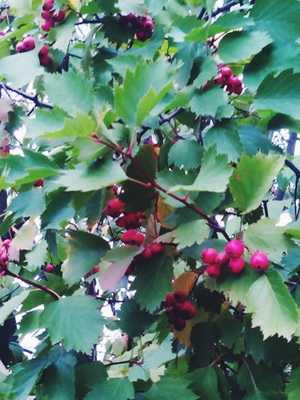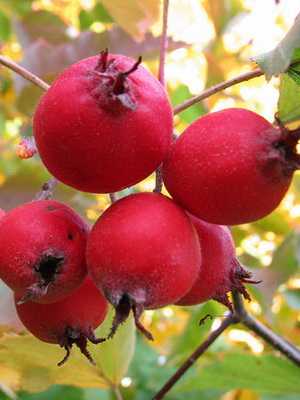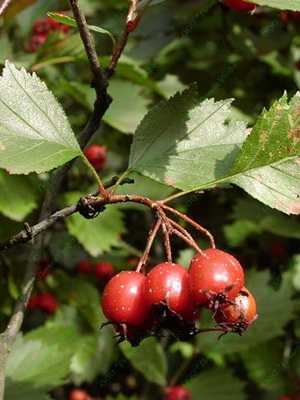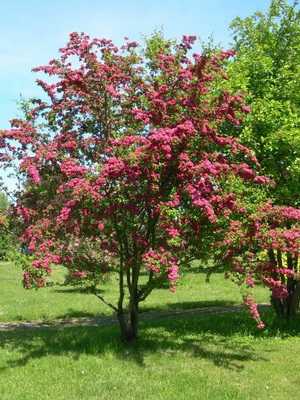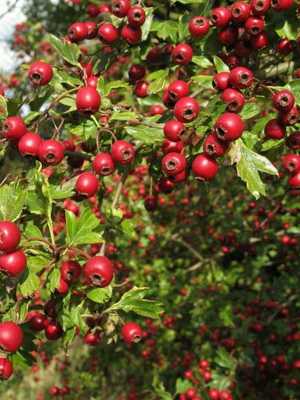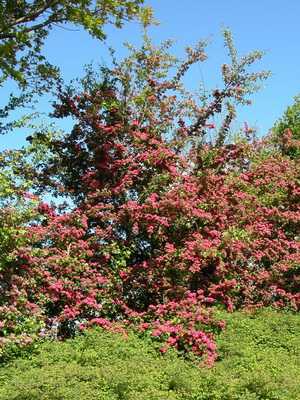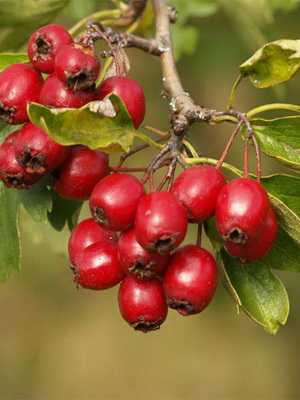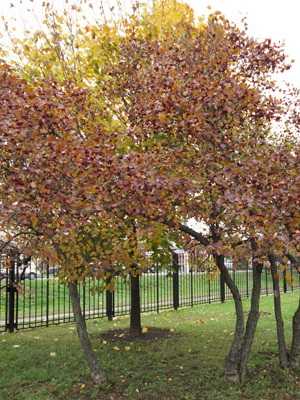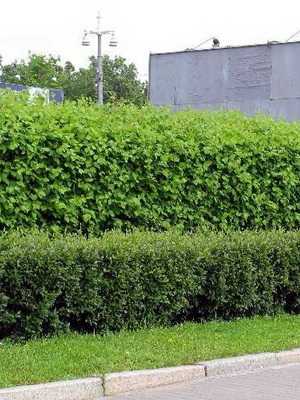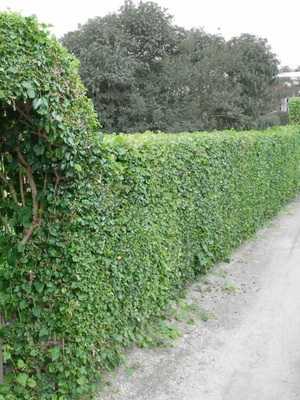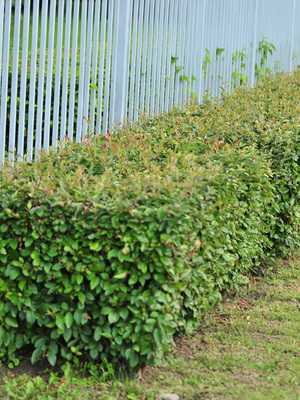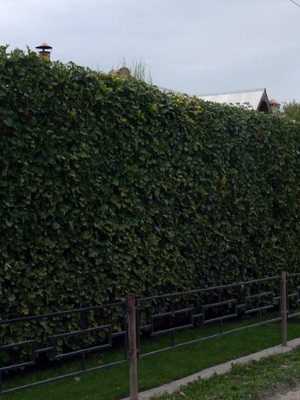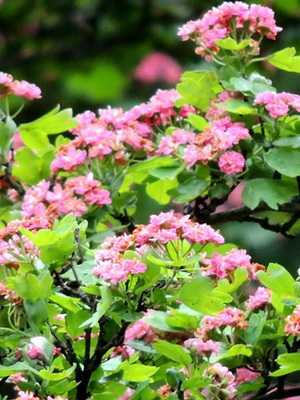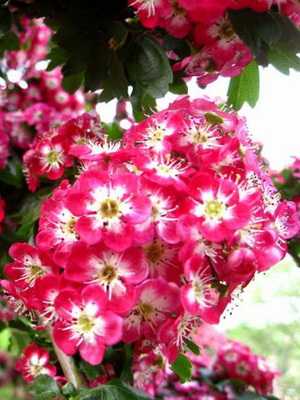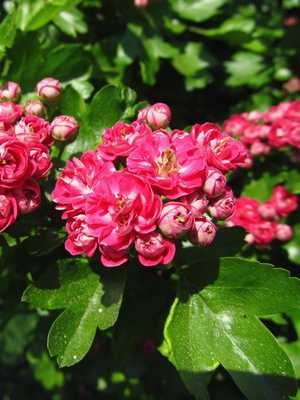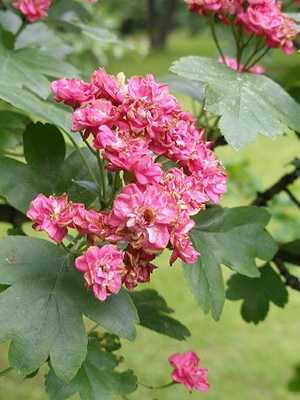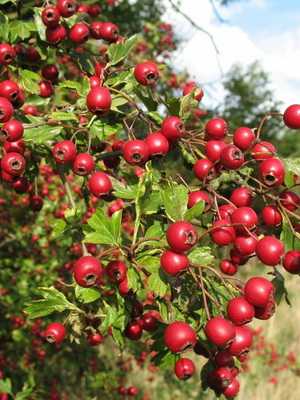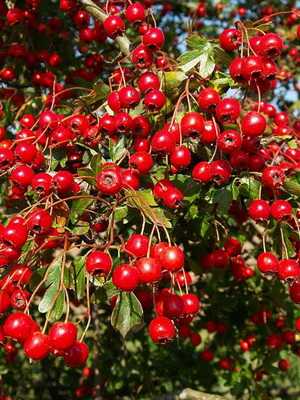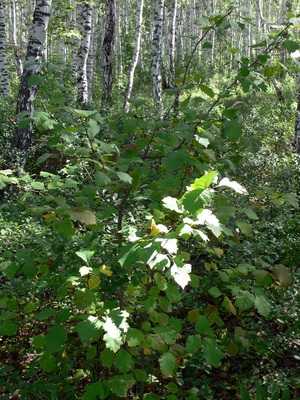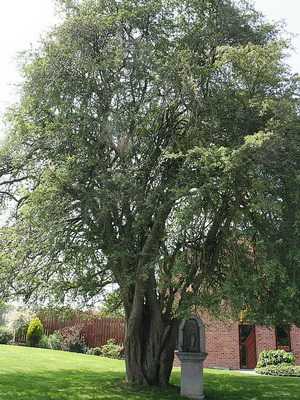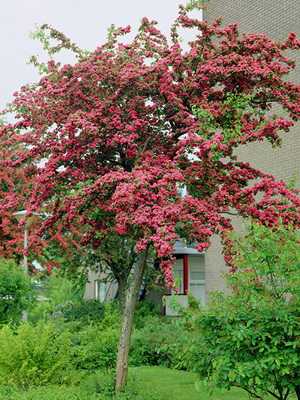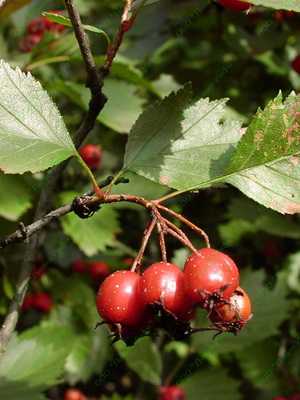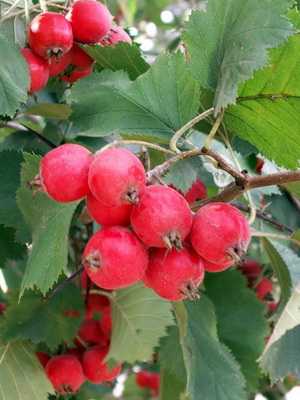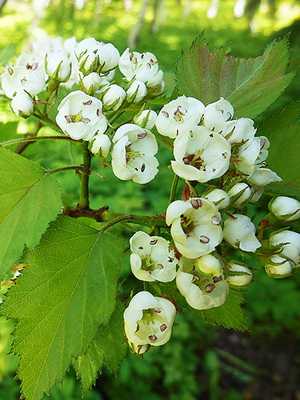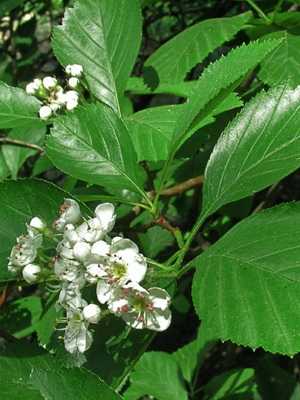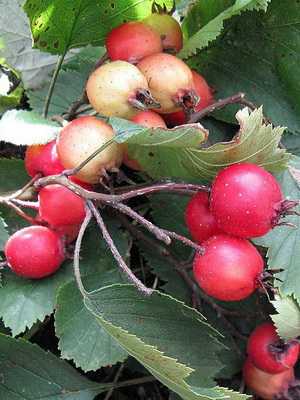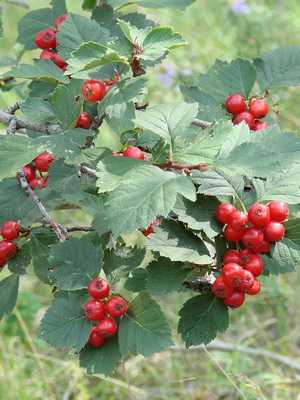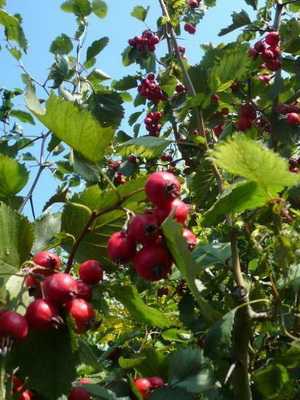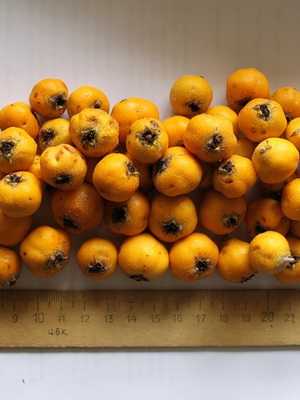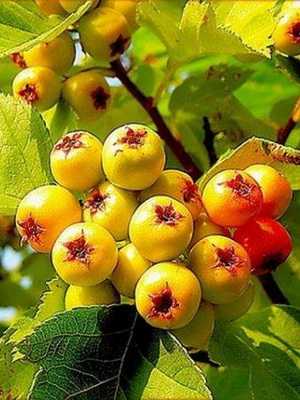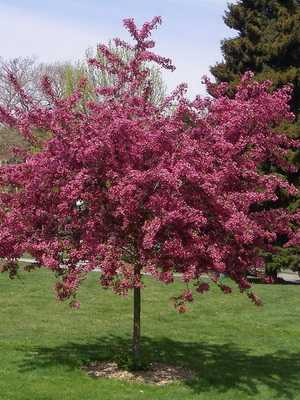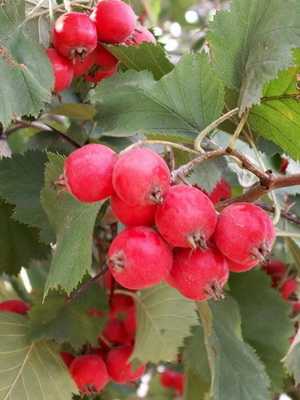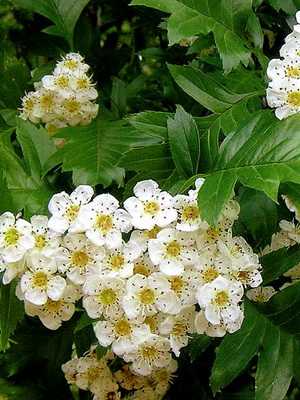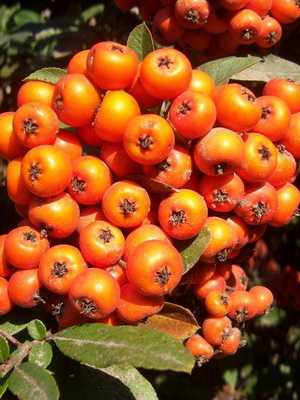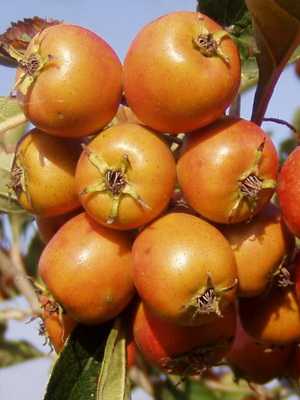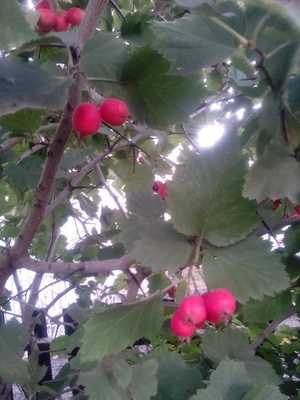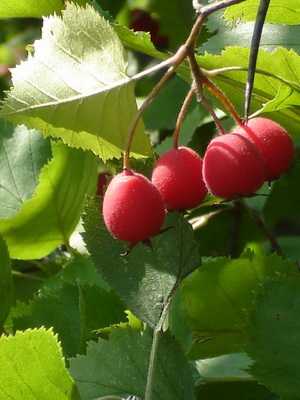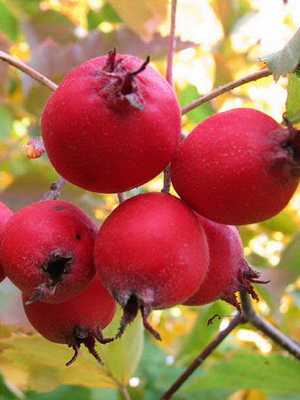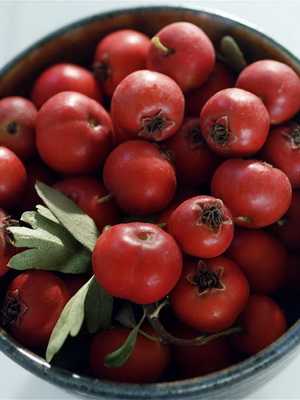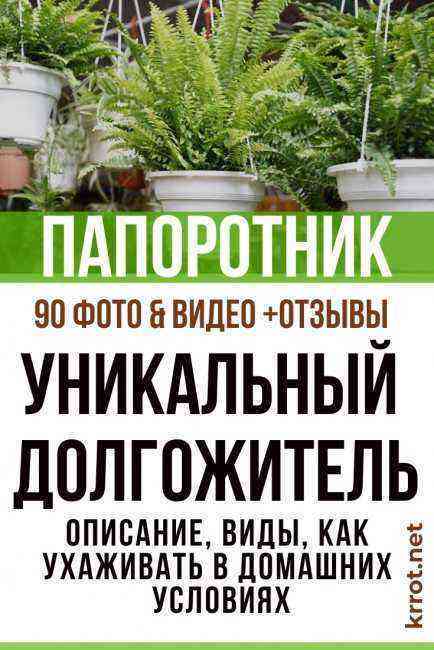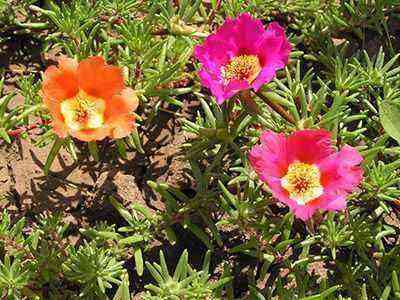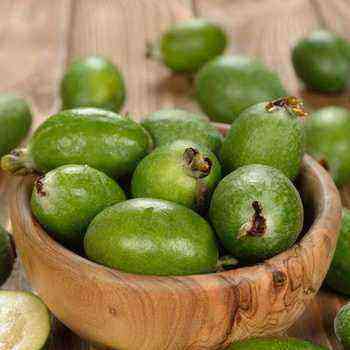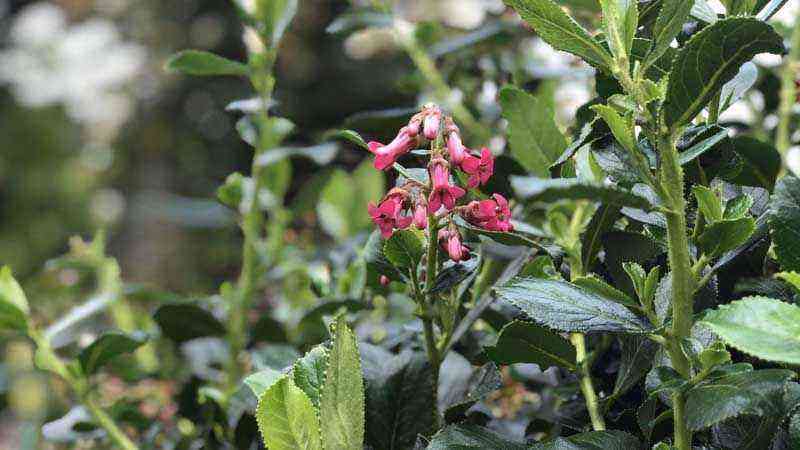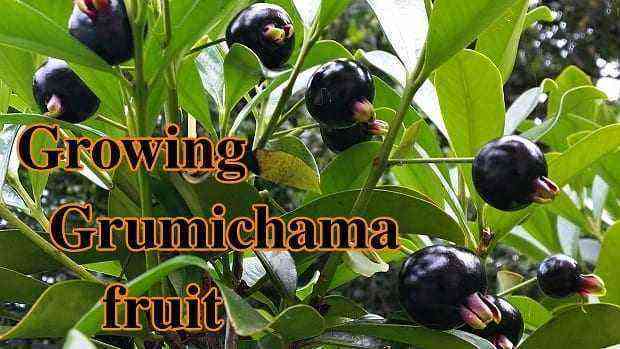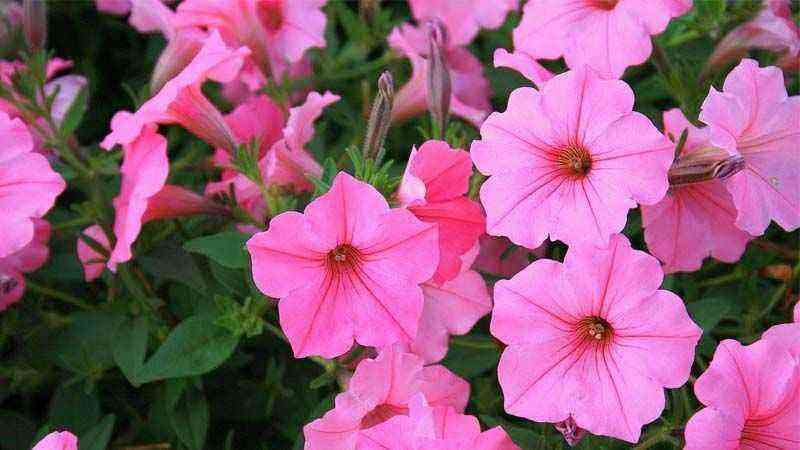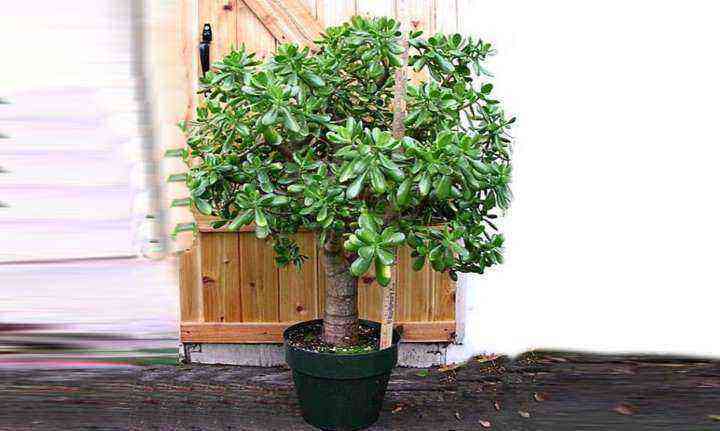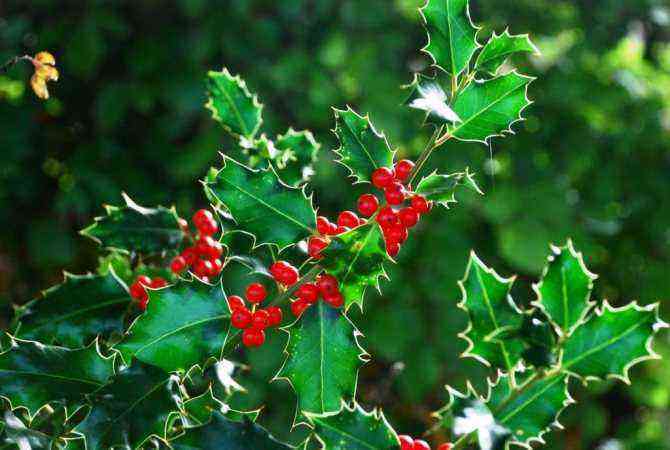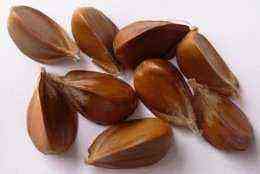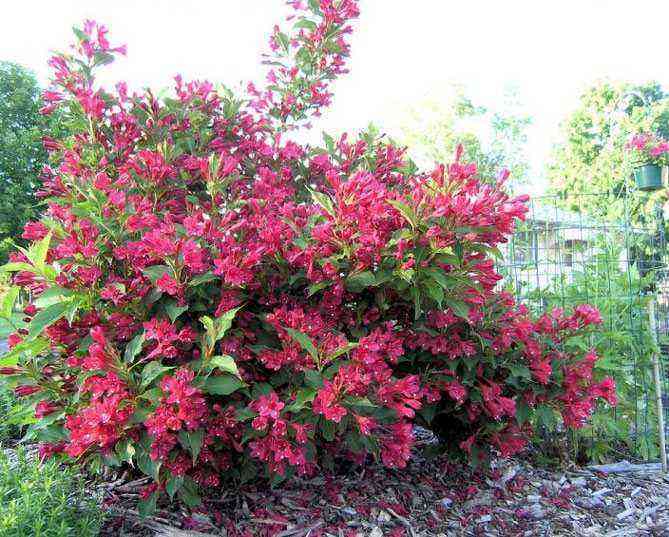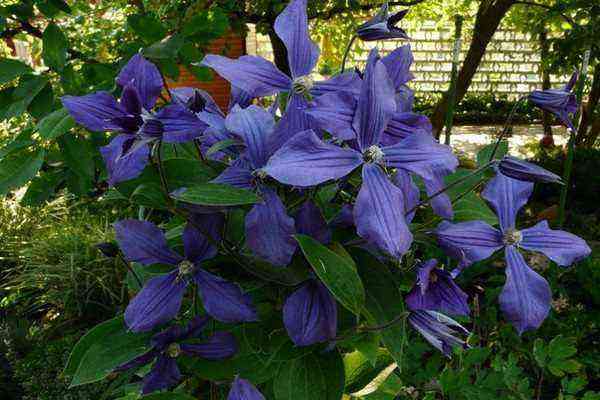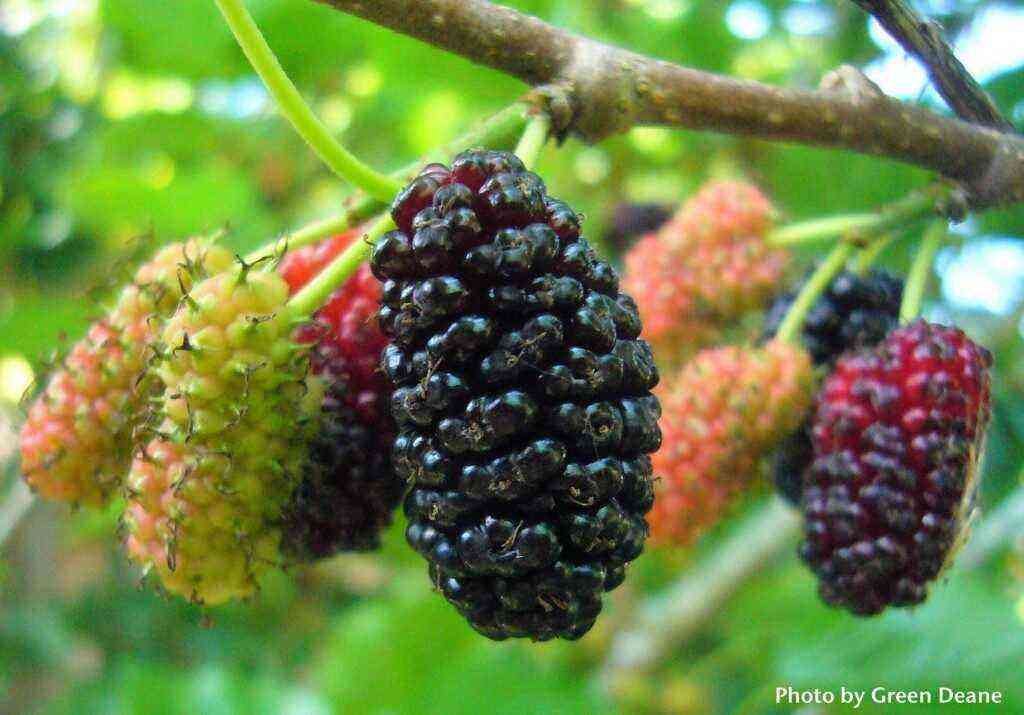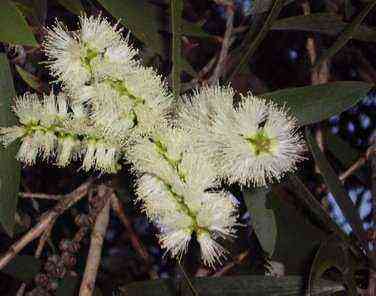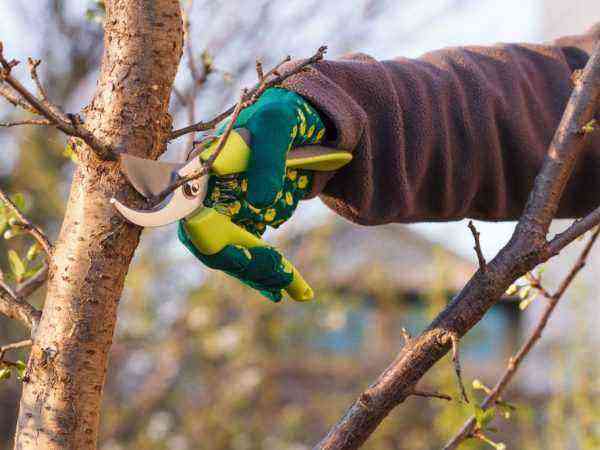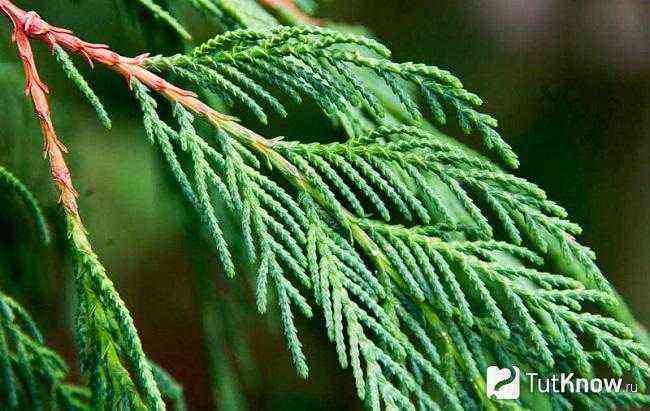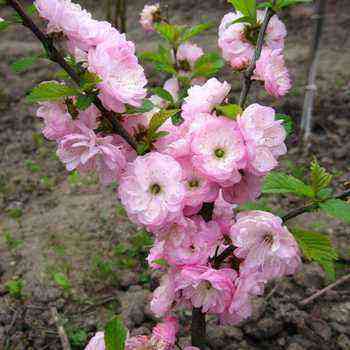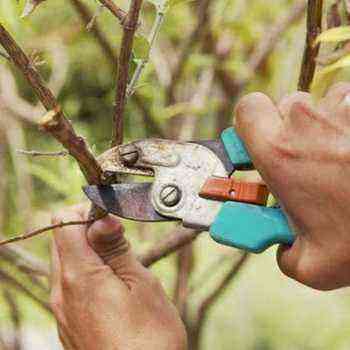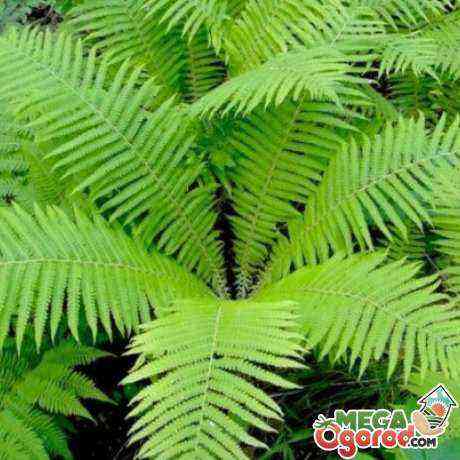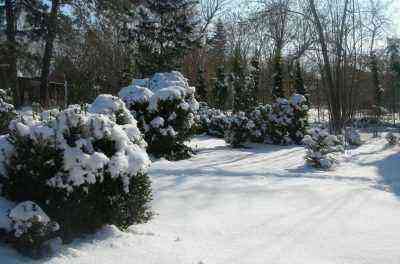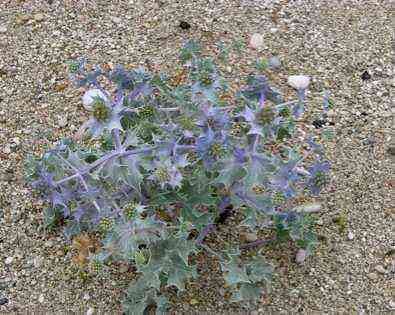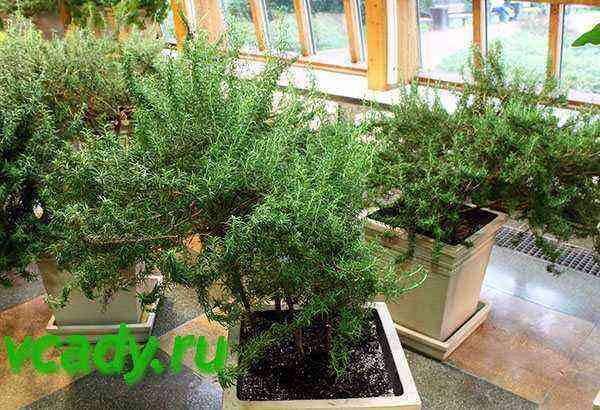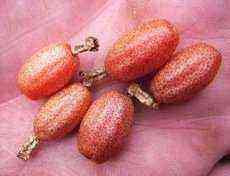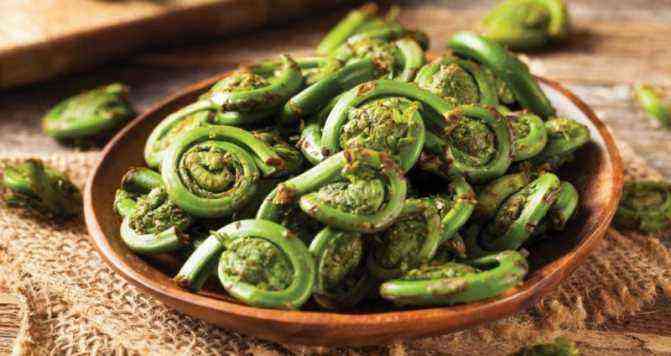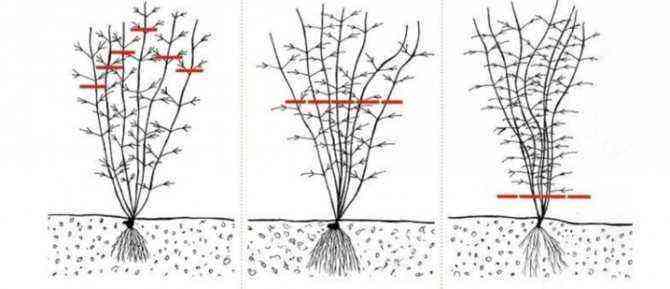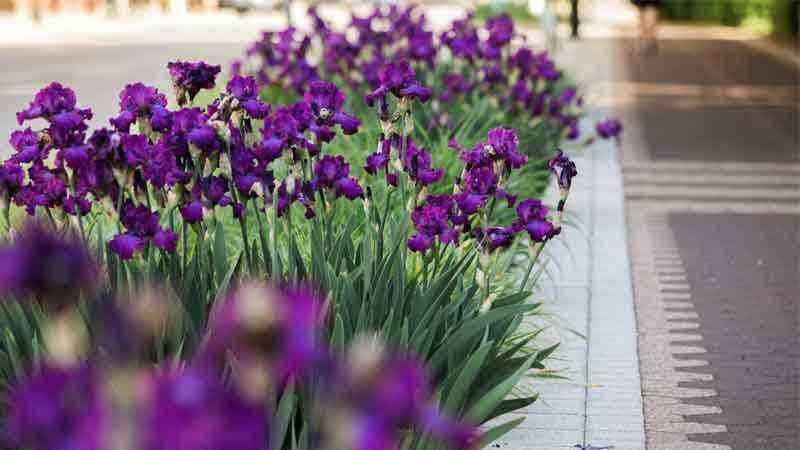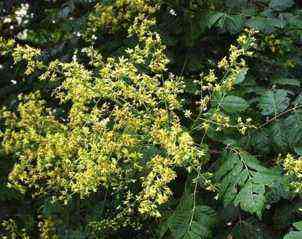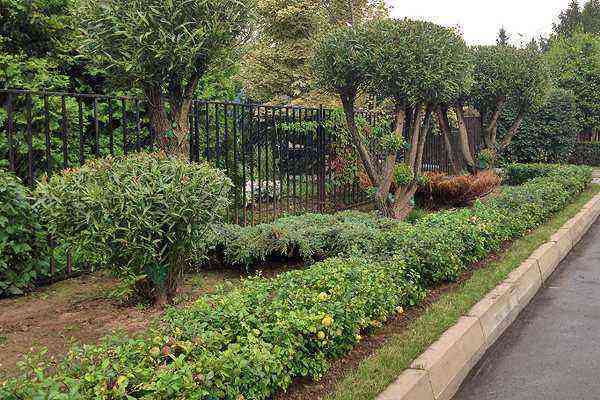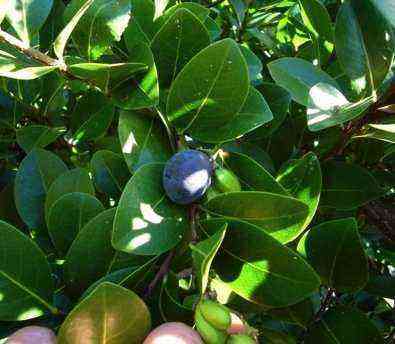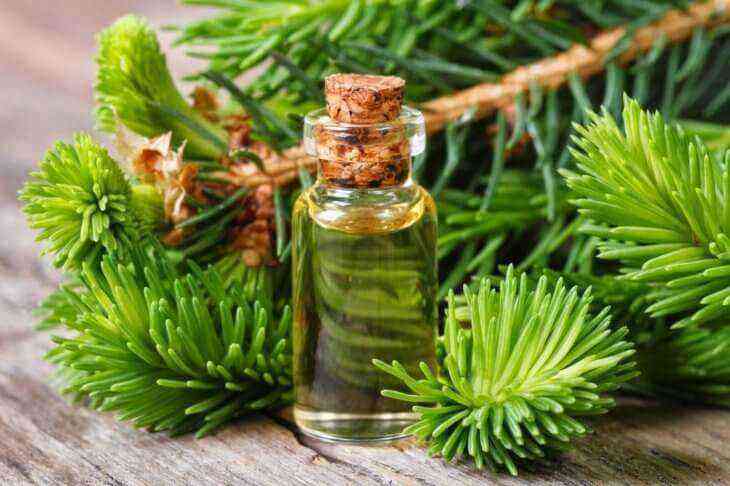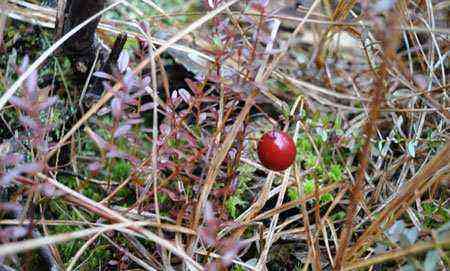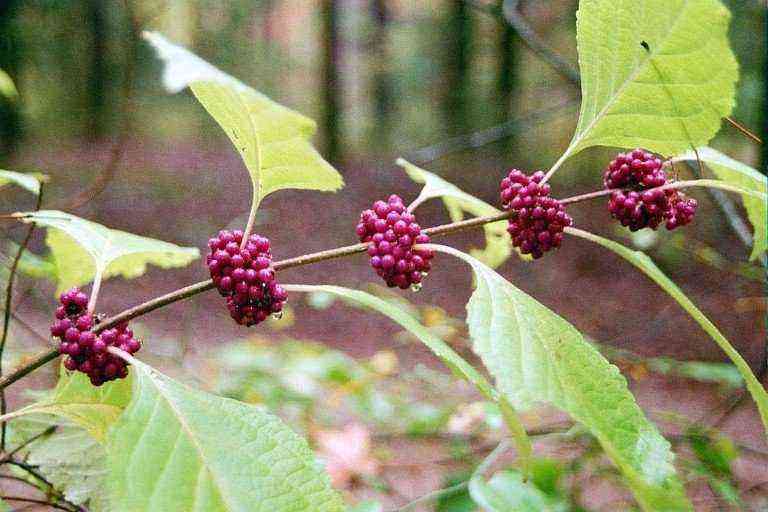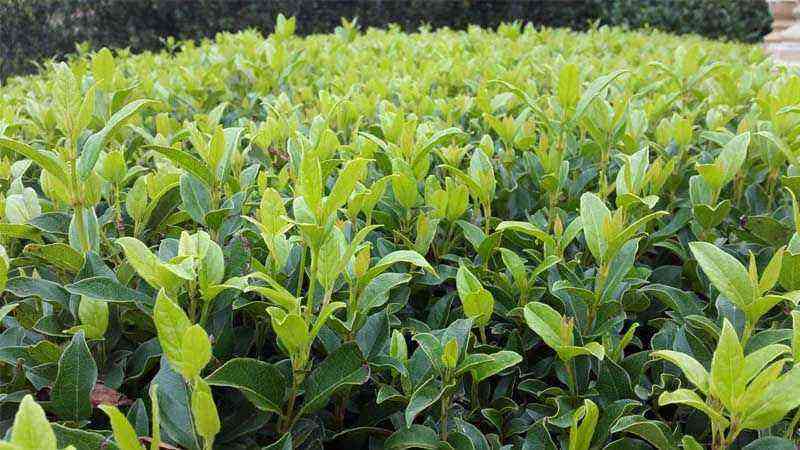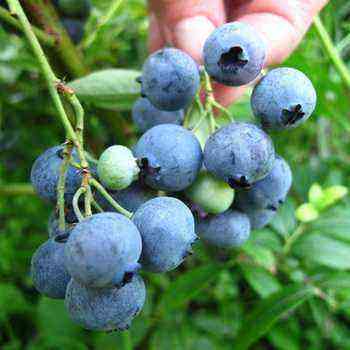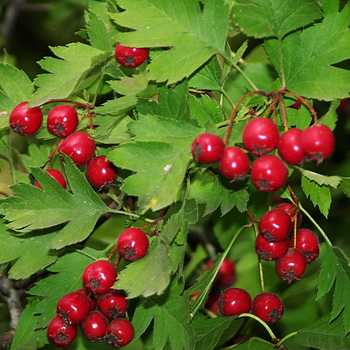
Family: Rosaceous.
Homeland – North America, Eurasia, Russia.
What does a hawthorn tree, leaves and fruits look like: characteristics and description, height and flowering (with photo)
The characteristic of the hawthorn plant begins with the fact that it is distributed mainly in the temperate regions of the northern hemisphere, mainly in North America, as well as Eurasia. There are 47 species of this plant on the territory of Russia. The most famous of them are blood red and Siberian. What a hawthorn tree looks like is known to many, even novice gardeners. Look at the hawthorn in the photo and in the description of the plant – this will allow you to get all the necessary knowledge for choosing seedlings:
A beautiful, spherical shrub up to 2,5 – 3 m high, sometimes low trees, shoots with numerous thorns up to 5 cm long. The height of the hawthorn tree is largely dependent on pruning and shaping. The crown is dense, round, spherical or ovoid, often asymmetrical. The leaves are pinnately-lobed, pinnately dissected or whole, gray-green or yellow-green in color. Hawthorn foliage is especially beautiful in autumn, when bright yellow or red colors are added to it. Brown bark. See how hawthorn leaves look in the photos offered on this page:
The flowers are white, less often pink or red, collected in semi-umbels or corymbose inflorescences. There are varieties with double flowers. Blooms in late spring – early summer (May – June). The hawthorn bloom in the photo impresses with its amazing beauty.
Hawthorn fruits are small dry or fleshy apples with 1–5 seeds. If the flowers of the hawthorn are the same, then the fruits can vary in shape, size, color. Moreover, they are all edible, but not always tasty. Often, hawthorn fruits can hang on the branches throughout the winter. The fruits ripen, depending on the species, in August – late October, they do not crumble for a long time. See how the hawthorn fruits look in the photo illustrating the fruiting process:
Hawthorn grows slowly. Begins to bear fruit from 10-15 years of age. But it lives for a long time – 200-300 years. In the East, the hawthorn was called “wild apple”: the hawthorn tree really looks like an apple tree, especially with its leaves and roots. The presented hawthorn tree in the photo and in the description can become the basis for the formation of a hedge or a shady corner of the garden.
More than 200 species of hawthorn are known. The most widespread are the following types:
Hawthorn ordinary, or barbed (C. oxiacantha)
Hawthorn blood red (C. sanguinea), point hawthorn (C. punctata) and etc.
When several species of hawthorns are grown together by cross-pollination, hybrids are easily formed.
Using
The presence of thorns and a dense crown allow the hawthorn to be used as a reliable hedge. A good shrub is also in single and group plantings.
Hawthorn is decorative, used for landscaping parks and squares. It is good for creating hedges. Hawthorn is widely used in green building, for protective afforestation. Has an important soil protection value in mountainous conditions. It is sometimes used in fruit growing as a stock for dwarf apple and pear trees. Hawthorn is a good honey plant. From the branches and bark, you can prepare a decoction for dyeing the fabric red. In addition, the bark is used in leather tanning.
Hawthorn wood is of great value. It is strong, viscous, has a beautiful texture, various joinery and art utensils are made of it, toys are cut out. Wood is used to make handles for shovels and percussion tools.
From the fruits of hawthorn, juices, jam, jam, jelly, marmalade and compotes are prepared. Fruits and flowers are widely used in medicine – for heart disease, insomnia, dizziness, shortness of breath.
Conditions for growing hawthorn and propagation from cuttings
The conditions for growing hawthorn are not supernatural, since it is an unpretentious plant. It is drought-resistant, photophilous, does not tolerate darkening, and is very winter-hardy. It does not need to be regularly watered, fertilized, the bush grows for several years and can withstand even severe frosts. Thanks to a well-developed root system, hawthorn thrives on any soil, but prefers loam or clayey, medium-fertile, calcareous soil. Reproduction and cultivation of hawthorn is best done in sunny areas. At a young age, all hawthorns, when cutting off the main trunk, easily take the form of a bush. Form-forming pruning should only be done after the first flowering.
It is mainly practiced to grow hawthorn from cuttings, since this allows the plant to quickly bring the plant into fruiting. To plant it, use a stalk, a piece of root with a layering (by grafting to another bush).
Planting hawthorn seeds: growing and care in the open field (with video)
Planting hawthorn seeds requires tremendous patience from the grower. Reproduction of hawthorn can occur by seeds that sprout in 1,5–2 years. In the first year, the seedlings grow by 10-12 cm. In the second year they are transplanted for growing, in the third year, the growth is cut off, leaving 2-3 buds above the soil level. This measure causes the rapid growth of the shrub. A more reliable method is propagation by root suckers or grafting the necessary shoots on the hawthorn monopod or thorny. Planting and caring for hawthorns in the open field will require timely feeding, without which it is difficult to get a healthy plant.
For planting, a greenish fruit is chosen, seeds are taken out of it, kept in a solution of potassium nitrate, then dried and left until spring in a cool dry place. A planting hole for one hawthorn bush should have a length and diameter of 60 cm.
Hawthorn is planted both in spring and autumn; to get fruit – in pits, to create a hedge – in a trench. Pits are dug with a diameter and depth of 60 cm at a distance of 1,5–2 m from each other. In each of them, 1–2 buckets of compost are added, and from mineral fertilizers – 5 tbsp. spoons of nitrophosphate. A trench is dug 60 cm wide, 50 cm deep. 1-2 buckets of compost and 4 tbsp. tablespoons of nitrophoska per 1 running meter. Bushes are planted in a trench every 40-50 cm.
Fruit trees (apple, pear, cherry, etc.) are not grown next to hawthorns, since they have common pests such as hawthorn, apple aphid, leafworm, cherry sawfly.
Begins to bear fruit in 5–6 years. Caring for him consists in weeding, loosening, feeding and in forming a crown. Bushes in hedges can be pruned to the desired height to encourage side branching.
In the second year after planting and in subsequent years before the beginning of fruiting, the hawthorn is fed 2 times.
The first feeding is carried out in the spring before flowering and when the leaves are blooming: 10 tbsp is diluted in 3 liters of water. spoons of “Potassium humate” universal, consumption – 15–20 liters per bush, depending on the age of the plant.
The second feeding is carried out in the fall (September): 3 tbsp. tablespoons of nitrophosphate per 10 liters of water, consumption – 15-25 liters per bush.
Fruiting bushes are fed 3 times. The first feeding is done in the spring before flowering and during the opening of the leaves: 2 tbsp. spoons of “Potassium humate” for fruit and berry crops and 2 tbsp. spoons of “Intermag” for fruit crops are diluted in 10 liters of water, the solution consumption is 20-30 liters per bush.
The second feeding is carried out at the beginning of flowering: 4 tbsp. spoons of “Potassium Humate” for fruit and berry crops are diluted in 10 liters of water, the solution consumption is 30–40 liters per bush.
The third feeding is done during fruiting: 3 tbsp. spoons of nitrophosphate are diluted in 10 liters of water, consumption – 30-40 liters per bush.
During the growing season and the period of fruiting, foliar dressing is carried out in the form of spraying with the growth regulator “Emistim”. Spray until the crown is completely wetted.
Hawthorn pests
Hawthorn is a host plant for a very large number of pests – fruit sawfly, apple blossom beetle, hawthorn fruit leaf beetle, cherry weevil, hawthorn gall midges, kidney mites, hawthorn leaf beetle, aphids, maple mealybug, arrowhead, acacia pseudophageus , pear mite, apple and wrinkled sapwood. Of the fungal diseases on this plant, mummification of fruits, powdery mildew, spotting, rust, black, central rot of the trunk are common. It is damaged by hawthorn and nematodes.
Against hawthorn, apple aphid, leafworm and sawflies, the bush is sprayed in the spring, before flowering, with a solution of the drug “Karbofos” (60 g per 10 liters of water). Processing is carried out in the morning or evening. The drug “Citcor” is also used (1,5 ml per 10 liters of water).
Hawthorn hedge: how to plant (with photo and video)
To create a hawthorn hedge in the first year after planting, it is necessary to cut the bush tightly, leaving hemp no higher than 10-15 cm from the soil level. This pruning is done in April and promotes the formation of powerful basal shoots. In the second year at the same time, to create a strong skeleton, deep pruning is again carried out, which ensures the appearance of new shoots and increased growth of last year’s ones. If the hedge is not thick enough, such a strong pruning is carried out in the third year. When pruning, try to make the hedge tapered. Usually, from the moment of emergence to the formation of a dense hedge with a height of 1,4 – 1,5 m, it takes up to 10 years. Before the annual shaping and shearing, a cord is pulled along the hedge to mark the border of the required haircut. The hawthorn hedge in the photo was grown in a similar way:
To create a hedge, you can use the following species that are widespread in the European part of Russia: prickly hawthorn (ordinary or smooth), blood-red hawthorn (Siberian) and single-footed hawthorn, which differs from prickly hawthorn by its rapid growth and pinkish tint of flowers. Hawthorn spur, or “cock’s spur” comes from the eastern regions of North America, and got its name from the long curved thorns that cover the shoots. But he is not hardy enough and tolerates a haircut worse than others.
When creating a hedge, it should be borne in mind that all hawthorns develop better, bloom profusely and bear fruit on well-drained, fertile sandy loams and loams with their obligatory liming, preferring open sunny spaces.
Since the roots of the hawthorn are located deep in the ground, only young, 3–6-year-old seedlings are selected for planting – older plants take root much worse.
Before planting hawthorn for a hedge, prepare a trench 40-50 cm wide (for a single-row) to 1 m (for a two-row hedge) and 50-70 cm deep. With poor soil, a mixture of equal parts of peat, humus and removed from earth trenches. Depending on the type of hedge, a planting pattern is chosen: 30-50 cm between plants in a single-row hedge, 50-70 cm for a two-row hedge, with a distance between rows of 50-60 cm. In the latter variant, plants are planted in a checkerboard pattern. To create formed living walls, one row of plants is laid according to the scheme 0,8-1,2 m, unformed (free-growing) – 1,2 m.
A hedge of the trellis type is more laborious to form, it is better to use plants of prickly hawthorn for it. In this case, 1–2-year-old seedlings are planted every 20–30 cm in one row along a temporary fence with poles horizontally located at a height of 25, 35 and 50 cm. A year after planting, the plants are cut “for reverse growth”, that is, on a stump 10 cm high. Of the newly grown shoots, only the two strongest shoots located in the plane of the trellis are left. A year later, these shoots are oriented in opposite directions at an angle of 45 degrees. In this case, the shoots of neighboring plants intersect with each other and (for better adhesion) at the places of their contact, part of the bark is cut off, and the combined areas are tightly wrapped with ribbons of plastic film and coated with garden pitch. The entire structure is attached to the lower transverse pole at a height of 25 cm, cutting off the branches protruding beyond this border.
In the spring of next year, two of the strongest, parallel shoots are left. In relation to the carrying branch of last year, they are located at an angle of 90 degrees. They are also crossed with neighboring shoots and tied at a height of 35 cm and cut off. In the fifth year, shoots are tied to the third pole. In the future, the trellis is trimmed like an ordinary hedge and brought to a height of 1,0-1,5 m, while from the sides it is sheared so that the width of the wall does not exceed 30 cm. The intertwined shoots grow together, thicken, and the windows-cells between them gradually overgrown. The result is a very strong, beautiful and impenetrable hedge, which also takes up very little space in width. If desired, the number of horizontal poles can be much larger, and they will be located much higher. Accordingly, the duration of the formation of this tall hedge is increased.
With a strong growth of shoots for hawthorns, a 2-3-fold haircut per season is permissible, and the deadline for the last pruning should be no later than mid-July. At the same time, 1 / 2–2 / 3 of the length of the current increment is cut off each time.
With a strong growth of shoots for hawthorns, a 2-3-fold haircut per season is permissible, and the deadline for the last pruning should be no later than mid-July. At the same time, 1 / 2–2 / 3 of the length of the current increment is cut off each time.
For low hedges, hawthorn can be cut into a rectangle, and for living walls it is better to make a trapezoidal profile with an angle of inclination of the side walls of 70-80 degrees, which allows the lower branches to receive sunlight too.
When creating such a hedge, it should be borne in mind that very careful and timely care is needed for this type of plantings. In the first two years after planting, irrigation and two-sided loosening of the soil in a zone of 50–80 cm from the plants themselves are required. Two years later, fertilizing with organic fertilizers in dry form is carried out – in the fall or early spring for digging. As a top dressing, use 2-4 kg of humus or compost or 2-3 kg of peat per 1 m2 of occupied area. Along with organic fertilizers, mineral fertilizing is also carried out. However, the rule is clearly followed here: phosphorus-potassium fertilizers are applied during the autumn digging of the soil, and nitrogen fertilizers only during early spring loosening. Per 1m2: ammonium sulfate 60–80 g, superphosphate 60–80 g, potassium salt 30–40 g.
It should be borne in mind that pests and diseases often use hedges, especially hawthorns, as intermediate hosts for the subsequent “attack” on the garden. Therefore, it is imperative to carry out chemical or biological protection against pests.
Types and varieties of hawthorn: description with photo
We propose to consider the species and varieties of hawthorn growing in the middle lane. All types and varieties of hawthorn with a photo offered on this page reproduce and grow quite easily in difficult climatic conditions.
Common hawthorn (C. laevigata = C. oxyacantha) is a very common species in Western Europe, which, with proper care, grows splendidly in the Middle Lane. Its branches are red-brown in color, they may contain rare spines up to 2,5 cm long. Shiny leaves can reach a length of 6 cm, they have a smooth surface with 3-5 lobes. Rarely flowering small inflorescences are formed by small white flowers. Red fruits are about 1,2 cm long, have 2-3 seeds inside. Common hawthorn is the founder of many excellent varieties:
Rubra, Crimson Cloud.
Punicea – have dark red flowers with a white center, Rosea flore plena – has double pink flowers.
Consider other types of hawthorn with a description and basic botanical characteristics.
Douglas hawthorn (C. douglasii) with proper pruning, it can form wide and dense bushes, and if not pruned, it grows into a large, spreading tree that bends the branches to the ground. There are practically no thorns on the red-brown branches, but in abundance there are shiny oblong leaves with lobes in the upper part up to 8 cm long.The dense and wide inflorescences are replaced by black shiny fruits with yellow sweet pulp about 1 cm in diameter.
The most common Asian species is hawthorn blood red (C. sanguinea). A photo of this hawthorn variety and a description allows you to decide whether such a culture is needed on the site. Its branches are reddish-brown and shiny, covered with thorns up to 4 cm long and abundant dark green foliage. The leaves are large, up to 10 cm long, with 3-4 deep lobes. Flowers are collected in small, about 5 cm, inflorescences. Ripe hawthorn fruits have a diameter of more than 1 cm, a red color, a glossy surface and a juicy mealy pulp. This variety is very similar to the dahurian hawthorn (C. dahurica) with smaller leaves, as well as the Maximovich hawthorn (C. maximowichii), which is distinguished by a more cut leaf shape.
There are other types of hawthorn, photos of which are offered further on the page. A brief description of the hawthorn variety will help determine the range of seedlings purchased for planting.
Siberian hawthorn distributed in the East of the European part of the country, mainly east of the Volga, in Western Siberia, in the south of the Urals, in the western and southwestern parts of Eastern Siberia, as well as in Transbaikalia. There is a lot of hawthorn in the Krasnodar and Stavropol Territories, in the Voronezh Region, in a number of republics of the North Caucasus. Grows singly or in small groups in sparse, deciduous and mixed forests, forest edges, clearings, river banks, mountain slopes, among bushes. Prefers fresh, fertile, alluvial soils of medium moisture. It tolerates shading, but develops better in open places.
In the Far East, in the basin of the middle and lower reaches of the Amur and Ussuri, a hawthorn is found in the form of a tree up to 6 m high.The spines are few in number, up to 2 cm long.Fruits are spherical or pear-shaped, up to 1,7 cm long, up to 1,5 cm in diameter, bright -red, shiny, with whitish warts, firm, with 3-5 bones and red dense flesh. The fruits are edible and have a sour taste. This hawthorn grows on sandy manes in riverside forests, less often it is found on gentle slopes of foothills with loamy soil, in the undergrowth of sparse oak forests and in felling areas. It is winter-hardy and heat-tolerant, as well as photophilous. Blossoms in May – June; fruits ripen in August – October.
Hawthorn prickly, nicknamed the lady, grows in the forests and shrubs of the southwestern part of the Transcarpathian region. In the middle lane, it is bred in park plantings like a hedge. The prickly hawthorn is a small thorny tree with alternate, more or less deeply dissected leaves. The flowers are small, usually white or reddish in color. The berries are red, but they can also be orange-yellow.
The following types of hawthorn can also be used as fruit plants:
Arnold, softish.
Holmes, Champlaisky, Elwanger and others.
They are distinguished by large fruits with a fairly high content of ascorbic acid and carotene, an average amount of polyphenols, and have a pleasant taste.
Of these species, the most valuable is the softish hawthorn. It is winter-hardy, bears fruit annually, and abundantly. These species can be recommended as a fruit crop. Their fruits are suitable for fresh and dried use. They are used to prepare juice and syrup, jam and compote.
Hawthorn rooster spur (C. crus-galli) – native to North America, has a low, wide and flat crown. The twisting branches are located in a horizontal plane, they have numerous strong thorns up to 10 cm long. On thick branches, thorns can wriggle and reach 20 cm in length. Large, up to 10 cm, dense leaves with clear veins. In the autumn, they shine beautifully and shimmer with orange and red colors. Large inflorescences are replaced by round fruits up to 1,5 cm in diameter with dry pulp and dirty green crust. Less dangerous for its thorns, but also beautiful in autumn, the hawthorn (C. x prunifolia).
Hawthorn is terrible, glandular or round-leaved (C. horrida = glandulosa = rotundifolia) – is a dense shrub with dense branches covered with thin and curved thorns. Rounded leaves up to 5 cm long, with sharp jagged edges, small lobes. Leaves turn yellow early in autumn. Large flowers give way to round red fruits. The fan-shaped hawthorn (C. flabellate) has numerous similarities with this species – a shrub with twisting olive-brown branches with strong curved spines up to 10 cm long and large leaves with small jagged lace edges. These varieties grow well in the climatic conditions of Central Russia.
Zbigniew. Shoots are geniculate, brown, later gray, with numerous spines 5-6 cm long. The leaves are large, broadly ovate, shallowly lobed, with a sharp tip and a rounded base, serrate, glabrous above, pubescent along the veins below. Fruits are spherical, up to 3,5 cm in diameter, bright red, with light dots, weighing 5,0 … XNUMX g. The pulp is juicy, sour-sweet, of excellent taste. It is appreciated for its high taste and early ripening.
Zlat. Shoots are straight, young, dark brown, tomentose, later gray or light brown with gray spots, practically without thorns. Leaves are small, with a wedge-shaped base, obovate, three to five-partite, with elongated, almost entire-edged lobes, light green, pubescent hairy. Fruits are spherical, ribbed, two cm in diameter, yellow, slightly pubescent, sour-sweet, tasty, weighing 2,5 … 4,0 g. Late ripening period – end of September. It is appreciated for its good taste, large fruit size, lack of thorns.
Chinese 1. Shoots are straight, young reddish-brown, with large white lenticels, later brown-gray, thornless. The leaves are large, with a wedge-shaped base, pinnately cut with serrate lobes, shiny, dark green above, lighter below, glabrous. Fruits are spherical, slightly flattened, three cm in diameter, maroon, with large light warts, sour, with firm pulp, weighing 10 … 20 g. Very late ripening – mid-October. Advantages – very large fruits, no thorns.
Chinese 2. Shoots are straight, young, dark brown, later gray, practically thornless. Leaves are medium in size, with a wedge-shaped base, pinnately cut with serrate lobes, shiny, dark green above, lighter below, glabrous. Fruits are elliptical, slightly faceted, 4 cm in diameter, dark red, shiny, with soft sweet pulp, weighing 5 … XNUMX g. Late ripening – early October. It is appreciated for its large size, lack of thorns, good taste.
Lyudmil. Shoots are straight, gray, usually thornless. Leaves are of medium size, obovate, sometimes with shallow lobes, with a wedge-shaped converging base, serrate, smooth above. Fruits are more or less spherical, 2,0 … 2,5 cm in diameter, light orange-red, with light dots, weighing 4,5 … 10,0 g. Juicy pulp, satisfactory taste. Late ripening – end of September. It is appreciated for its large-fruited nature, long shelf life of fruits, and the absence of thorns.
Shamil. Shoots slightly geniculate, brown, later gray, with a few spines three to four cm long. The leaves are large, broadly ovate, with shallow lobes, with a sharp tip and usually rounded base, serrate, rough on top. Fruits are spherical, 4 cm in diameter, red, with light dots, with large sepals, weighing 6 … XNUMX g. The pulp is juicy, sour-sweet, of excellent taste. Late ripening – end of September. It is appreciated for its large size, excellent taste.
All of the above varieties, except for Zlata, are characterized by high winter hardiness and can grow in most of the European territory of Russia. The limiting factor for them is heat supply and, as we move to the north, the fruits of late-ripening varieties may not acquire their inherent qualities.
These varieties grow in a sharply continental climate, but they do not tolerate soil freezing and low temperatures. Therefore, at a young age, ornamental shrubs should be covered with spruce branches in winter and protected from active sunlight in the first 2 years.
When hawthorn begins to bear fruit after planting
Most gardeners are concerned about when the hawthorn begins to bear fruit after planting, how many years will have to wait for the first harvest. Most varieties give their first harvest after 2 years.
Attention! Do not pick flowers in the morning (with dew) and after rain.
The berries are harvested in the fall when ripe, when the foliage is crumbling and they are especially clearly visible on bare branches. Tear off the entire shield, then remove all the stalks, unripe and spoiled fruits. The collected raw materials are scattered on tin trays in a thin layer and placed in a heated, but not hot oven. From time to time, the berries are mixed, removing the burnt ones, and the dried ones are poured into bags or plywood boxes. Properly dried raw materials can be stored for up to eight years without losing their healing properties.
What is valuable in a hawthorn?
Blood-red hawthorn is most suitable for treatment. It contains flavonoids, saponins and other compounds. Fruits contain a lot of sugars, starch, organic acids, pectin substances, as well as vitamins C (hawthorn fruits contain more ascorbic acid than even oranges, and in some species the content of vitamin C is even higher than that of rose hips!), B, E, K , carotene, trace elements: potassium, calcium, manganese, magnesium, iron. The seeds contain a fatty oil.
From the fruits of hawthorn, preparations are prepared that are useful for vascular spasms, headaches, shortness of breath, insomnia, atherosclerosis, and hypertension. Hawthorn is also able to purify the blood.
The people call the hawthorn “the bread of the heart”. It is not difficult to understand why. Hawthorn helps the heart beat evenly, improves blood supply to blood vessels and the brain, lowers the excitability of the central nervous system, increases blood circulation in the coronary vessels, relieves mental and physical fatigue, and normalizes sleep. Hawthorn preparations are especially useful for women in menopause and for the elderly. The most effective preparations are made from fresh flowers. Hawthorn berries are especially useful for patients with diabetes mellitus. The liquid extract of the fruit is part of the well-known drug – cardiovalene. It has low toxicity and has a stimulating effect on a tired heart, lowers blood cholesterol levels. After taking hawthorn preparations with regular courses, well-being noticeably improves, blood pressure decreases, headache, dizziness, noise in the head or ears decrease or disappear, blood cholesterol content decreases and lecithin concentration increases, there is a tendency towards normalization of blood clotting indicators. Many modern doctors believe that hawthorn is one of the best means of preventing diseases of the cardiovascular and nervous systems. This is explained by the fact that it causes the expansion of blood vessels, has a mild diuretic effect, and accelerates recovery after a serious illness. Some argue that hawthorn with black fruits is especially useful for those suffering from atherosclerosis and tumor diseases: its fruits are rich in anthocyanins – opponents of free radicals.
Attention! Hawthorn preparations should not be used during pregnancy and breastfeeding.
Decoctions and tinctures should not be taken on an empty stomach – only half an hour after eating.
People with low blood pressure should take hawthorn with caution, keeping in mind the ability of hawthorn to reduce blood pressure.
Do not take hawthorn for too long, it can cause depression of the heart rate.
